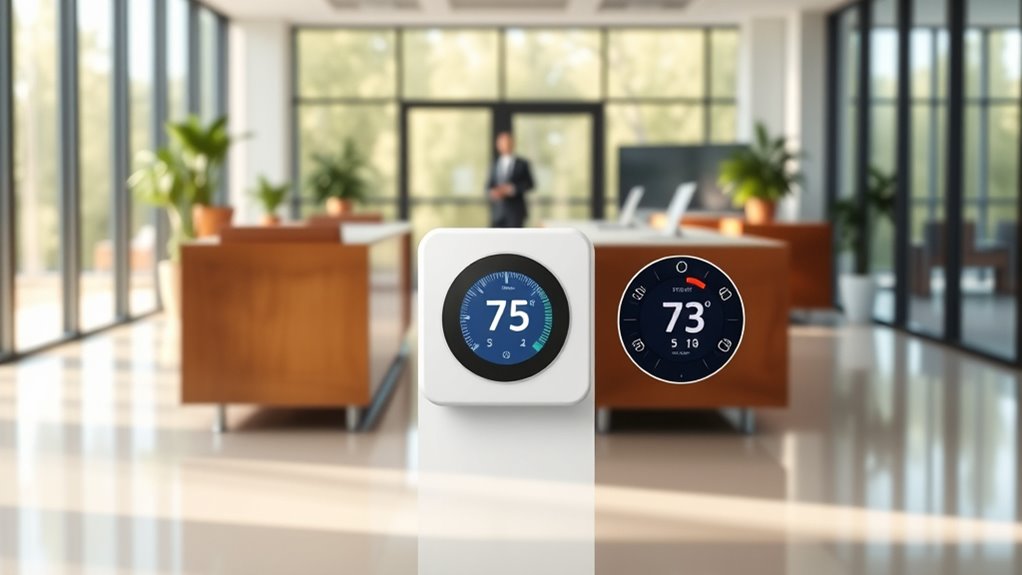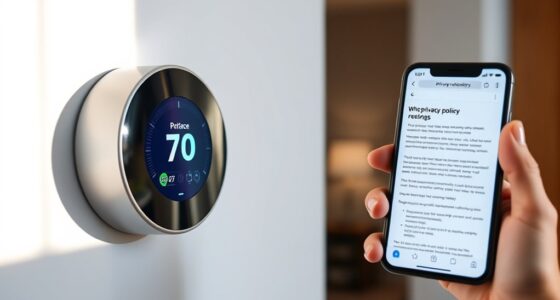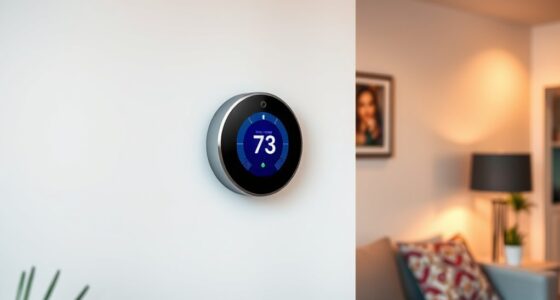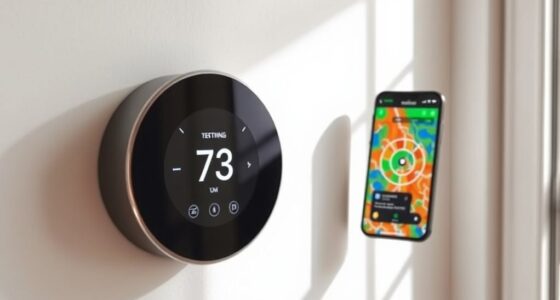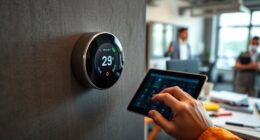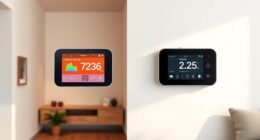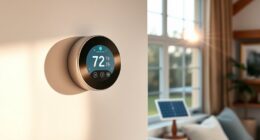When choosing a smart thermostat for your business or small office, focus on models that offer easy-to-use interfaces and remote control features, so you can adjust settings effortlessly. Look for units compatible with your existing HVAC systems to avoid costly upgrades. Prioritize energy-saving capabilities that optimize your heating and cooling schedule based on occupancy, helping you save on utility bills while maintaining comfort. For detailed tips, explore further to find the perfect fit for your workspace.
Key Takeaways
- Ensure compatibility with existing HVAC systems to avoid costly modifications.
- Choose user-friendly interfaces for easy adjustments by staff or building managers.
- Prioritize energy-saving features like occupancy-based scheduling and detailed consumption reports.
- Opt for remote control capabilities via smartphone or tablet for flexible climate management.
- Consider integration options that support sustainability goals and enhance overall comfort.
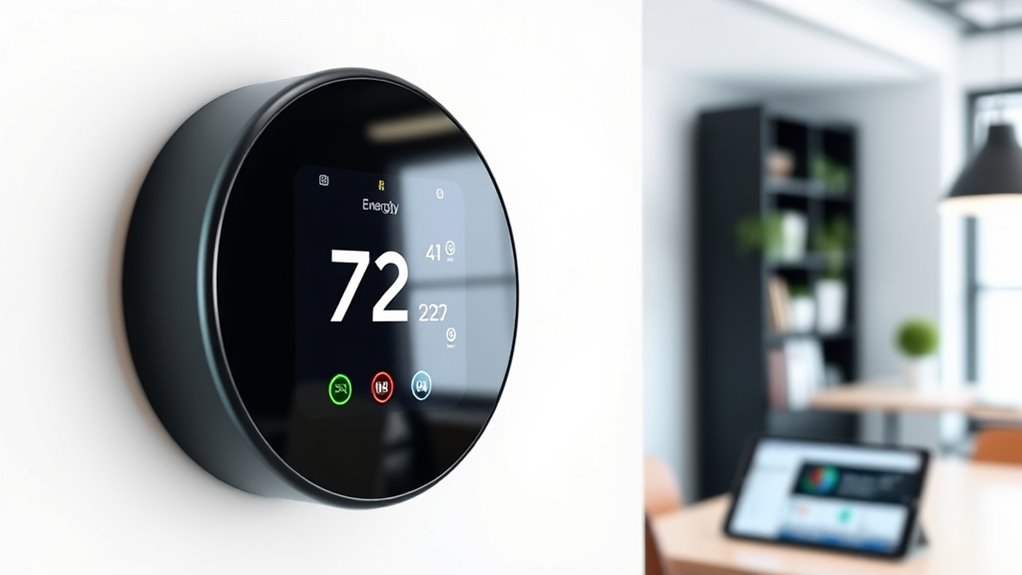
Choosing a smart thermostat can considerably improve your home’s comfort and energy efficiency. While this is often emphasized for residential settings, it’s just as valuable for businesses and small offices. When you’re selecting a device for your workspace, one of the most important factors to consider is how it can help you achieve energy savings without sacrificing comfort. Smart thermostats are designed to optimize heating and cooling schedules based on your occupancy patterns, which means you can reduce energy waste during unoccupied hours. This not only lowers utility bills but also supports your company’s sustainability goals.
Smart thermostats enhance comfort and energy savings for businesses and offices alike.
Another critical aspect is the user interface. In a business environment, you want a thermostat that’s easy to operate for staff members or building managers who might not be tech-savvy. A well-designed user interface allows for quick adjustments, clear visualization of current settings, and seamless programming. Look for a device that offers a straightforward touchscreen or an intuitive app, so you can easily modify temperature settings or set schedules without wasting time navigating complicated menus. The ability to control the thermostat remotely via a smartphone or tablet is also a huge plus, enabling you to make adjustments on the go, whether you’re in the office or away.
Ease of use directly impacts how effectively your staff can participate in maintaining optimal comfort levels. A complicated system can lead to inconsistent settings or neglect, which undermines energy savings efforts. Conversely, a user-friendly interface encourages regular engagement, making it simple to fine-tune temperature settings as needed. Many smart thermostats also provide visual cues, alerts, or reports that help you monitor energy consumption and identify opportunities for further savings. This transparency empowers you to make informed decisions about your HVAC usage, ensuring that your business remains both comfortable and cost-efficient.
Furthermore, compatibility with existing heating and cooling systems is essential. Some thermostats work better with certain types of HVAC setups, so you’ll want to verify that the device you select integrates smoothly with your current infrastructure. This eliminates the need for costly modifications and guarantees that you get the full benefit of smart automation. Incorporating aesthetic wall organization solutions can also improve the overall look of your workspace, making control devices more accessible and visually appealing. When combined with features like energy tracking and user-friendly controls, a compatible thermostat becomes a powerful tool to streamline operations, reduce costs, and maintain a comfortable environment for employees and clients alike.
Frequently Asked Questions
How Does a Smart Thermostat Improve Energy Efficiency?
A smart thermostat improves energy efficiency by automatically adjusting the temperature based on your schedule and preferences, leading to significant energy savings. It detects when spaces are unoccupied and reduces heating or cooling accordingly, which cuts down unnecessary energy use. This not only boosts your environmental impact by lowering carbon emissions but also helps you save money on utility bills. With a smart thermostat, you optimize comfort while making eco-friendly choices effortlessly.
Can Smart Thermostats Be Integrated With Existing HVAC Systems?
Think of your HVAC system as a well-orchestrated symphony; smart thermostats can often step in as the conductor. You can usually integrate them with existing HVAC systems, but you’ll want to verify HVAC compatibility first. During installation considerations, make certain the thermostat is compatible with your system’s wiring and controls. Most models are designed for easy integration, but consulting an expert guarantees a smooth harmony between new tech and your current setup.
What Security Features Are Available to Protect Smart Thermostat Data?
You can safeguard your smart thermostat data with key security features like data encryption and access controls. Data encryption guarantees your information stays private during transmission and storage, while access controls restrict device usage and data access to authorized personnel only. By enabling these features, you protect your system against unauthorized access, maintaining the security and integrity of your business data and preventing potential cyber threats.
How User-Friendly Are Smart Thermostats for Employees or Staff?
Smart thermostats are generally user-friendly for employees, thanks to intuitive user interfaces that make adjusting settings simple. You’ll find clear menus and touchscreens that require minimal training, but providing some employee training can help everyone use features effectively. This guarantees staff feel confident managing temperature controls, saving energy, and avoiding unnecessary adjustments. Overall, most models are designed with ease of use in mind, making daily operation smooth for your team.
What Is the Typical Cost-Benefit Timeline for Installing a Smart Thermostat?
You’ll see cost savings within 6 to 12 months after installation, making the investment worthwhile. While the installation timeline is quick—often just a few hours—you might worry about upfront costs. However, energy efficiency leads to lower utility bills, which quickly offset initial expenses. Over time, smart thermostats streamline temperature control, reduce waste, and improve comfort, ensuring your business gains long-term benefits from a smart investment.
Conclusion
Think of choosing a smart thermostat like planting a tree in your office garden. With the right choice, it grows effortlessly, adapting to your needs and providing comfort like invigorating shade on a hot day. As your business flourishes, this device becomes a steady guardian of your environment, saving energy and money. Select wisely, and you’ll nurture a smart, sustainable space that thrives along with your success. Your perfect thermostat is the seed for a comfortable future.
